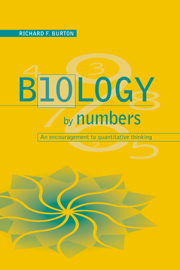Book contents
- Frontmatter
- Contents
- Preface
- A guide to the book
- 1 Putting two and two together
- 2 Units, formulae and the use of old envelopes: confronting some obstacles to quantitative thinking
- 3 Aspects of energy metabolism
- 4 Getting things in proportion
- 5 Perilous percentages, dangerous ratios
- 6 Building a trophic pyramid
- 7 Sodium in animals and plants
- 8 Exchanges of water and carbon dioxide
- 9 A geometric series
- 10 Introduction to logarithms
- 11 Bringing logarithms to life
- 12 Exponential relationships
- 13 Aspects of allometry
- 14 More on allometry, and on quantitative patterns in nature
- 15 How the abundance of food affects rates of feeding
- 16 The characterization of trees and other branching systems
- 17 Epilogue
- References
- Notes
- Index
15 - How the abundance of food affects rates of feeding
Published online by Cambridge University Press: 05 June 2012
- Frontmatter
- Contents
- Preface
- A guide to the book
- 1 Putting two and two together
- 2 Units, formulae and the use of old envelopes: confronting some obstacles to quantitative thinking
- 3 Aspects of energy metabolism
- 4 Getting things in proportion
- 5 Perilous percentages, dangerous ratios
- 6 Building a trophic pyramid
- 7 Sodium in animals and plants
- 8 Exchanges of water and carbon dioxide
- 9 A geometric series
- 10 Introduction to logarithms
- 11 Bringing logarithms to life
- 12 Exponential relationships
- 13 Aspects of allometry
- 14 More on allometry, and on quantitative patterns in nature
- 15 How the abundance of food affects rates of feeding
- 16 The characterization of trees and other branching systems
- 17 Epilogue
- References
- Notes
- Index
Summary
This chapter is about two related topics, the effect of prey abundance on predation rates and the effect of plant food availability on grazing rates. The point of it, aside from this biological content, is partly to utilize ideas from earlier pages, including exponentials and the rectangular hyperbola of equation 2.5, and partly to provide further illustration of an approach to quantitative biology that has otherwise found little place in this book, namely mathematical (algebraic) modelling. This is accomplished without the introduction of new forms of equation.
Rates of predation and the abundance of prey
Imagine a hungry praying mantis that shares a container with some flies. One would expect that the rate of capture would increase with the density of flies – but only up to a point, because eating takes time and puts an upper limit on the rate of capture. Thus, in a graph of consumption rate against fly density, one might expect near-proportionality at low densities and a plateau at high densities.
To explore this situation in the algebraic terms of a simple model, it may be assumed that the mantis divides its time between waiting in ambush for its prey and handling them (i.e. capturing, subduing and eating them, and perhaps taking a ‘digestive pause’). Let us say that the mantis catches a total number of flies, N, in a total period, Tt, when the flies are present at density X.
- Type
- Chapter
- Information
- Biology by NumbersAn Encouragement to Quantitative Thinking, pp. 189 - 198Publisher: Cambridge University PressPrint publication year: 1998



